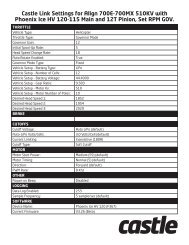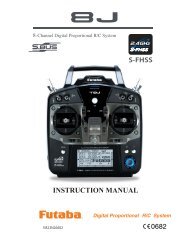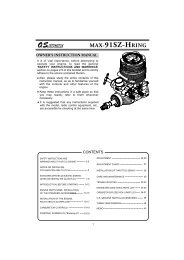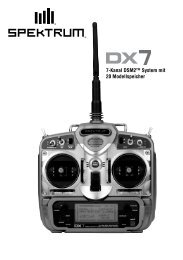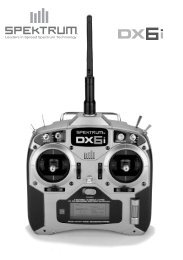Instruction for setting the ICE2 HV 120 governor mode with 800MX
Instruction for setting the ICE2 HV 120 governor mode with 800MX
Instruction for setting the ICE2 HV 120 governor mode with 800MX
You also want an ePaper? Increase the reach of your titles
YUMPU automatically turns print PDFs into web optimized ePapers that Google loves.
Motor Timing:<br />
Motor timing advance changes <strong>the</strong> timing advance range used on <strong>the</strong> motor. Generally,<br />
low advance gives more efficiency and less power. High advance gives more power at <strong>the</strong><br />
expense of efficiency (motor heat). Every system will respond to changes in advance<br />
differently. All Castle Creations controllers automatically determine <strong>the</strong> correct and best<br />
range of timing advance <strong>for</strong> any motor <strong>the</strong>y are plugged into when running in sensoreless<br />
<strong>mode</strong>. You can move up or down <strong>with</strong>in that range via <strong>the</strong>se <strong>setting</strong>s. The <strong>setting</strong><br />
parameter is 0 to 20, higher value equals higher advancement. Default factory <strong>setting</strong> is<br />
Normal (5).<br />
<strong>800MX</strong> features high torque, allowing rapid startups <strong>with</strong>out advancing timing. We<br />
recommend “Low (0)” or “Normal (5)” <strong>setting</strong>s.<br />
PWM Rate:<br />
This <strong>setting</strong> changes <strong>the</strong> frequency <strong>with</strong> which <strong>the</strong> controller sends power pulses to <strong>the</strong><br />
motor. With some motor types, <strong>the</strong> higher <strong>the</strong> frequency <strong>the</strong> more efficient <strong>the</strong> motor will<br />
run, but always at <strong>the</strong> expense of increased heat <strong>with</strong>in <strong>the</strong> controller. If you decide to<br />
experiment <strong>with</strong> changes to PWM, use a wattmeter, a tachometer and a temperature gun to<br />
find out how changes affect your entire power system. An increase in PWM frequency<br />
will always increase <strong>the</strong> controller temperature. It may or may not decrease <strong>the</strong><br />
temperature of <strong>the</strong> motor.<br />
<strong>800MX</strong>’s unique winding and magnet design contributes to an already efficient motor,<br />
so even <strong>with</strong> increased PWM values, <strong>the</strong> motor can continue to keep <strong>the</strong> operating<br />
temperature low. O<strong>the</strong>r brands of motors <strong>with</strong> single winding will not be able to handle<br />
higher PWM <strong>setting</strong>s (<strong>the</strong>y recommend 8Khz). For <strong>800MX</strong> motor, we recommend PWM<br />
value of 8 to 12 Khz, or <strong>the</strong> “Outrunner Mode.”<br />
Warning tones and LED signals:<br />
Castle <strong>ICE2</strong> <strong>HV</strong> <strong>120</strong> provides 6 different LED signals, as well as warning beeps, to alert<br />
you any abnormalities that occurred in flight, such as loss of power or loss of signal.<br />
In case you were <strong>for</strong>ced to land by an abnormal incidence, do not unplug <strong>the</strong> ESC power<br />
immediately; observe <strong>the</strong> warning LED and beeps to understand <strong>the</strong> cause of abnormality.<br />
1 beep and flash Start failure: The motor was jammed or locked.<br />
2 beeps and flashes Low Voltage Cutoff: Your batteries are likely discharged.<br />
Check that batteries are fully charged and that Phoenix<br />
detects <strong>the</strong> proper number of cells at power-up.<br />
3 beeps and flashes Over-Current: Current draw exceeded <strong>the</strong> safe capacity of<br />
<strong>the</strong> controller. Reduce current draw by changing to a<br />
smaller propeller, different gear combination, or fewer<br />
cells.<br />
4 beeps and flashes Motor Anomaly: Controller encountered abnormal motor<br />
behavior such as a prop strike or o<strong>the</strong>r physical<br />
interference. May also indicate lost synchronization or<br />
magnetic overload <strong>with</strong>in <strong>the</strong> motor.<br />
5 beeps and flashes Radio Signal: Signal from receiver is corrupt or nonexistent.<br />
Check transmitter and receiver.<br />
6 beeps and flashes Over temperature




